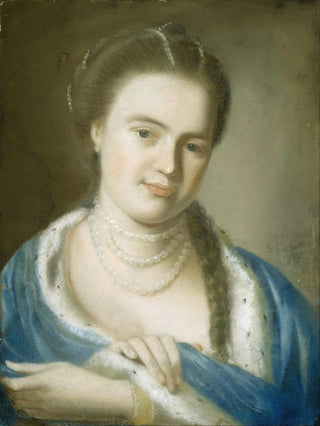Art print | Portrait of Mrs. Gawen Brown - John Singleton Copley


View from behind

Frame (optional)
Portrait of Mrs. Gawen Brown - John Singleton Copley – Captivating Introduction
The "Portrait of Mrs. Gawen Brown" by John Singleton Copley is an iconic work that embodies the very essence of 18th-century portraiture. Created with remarkable precision, this painting goes beyond a simple physical representation. It transcends time and space, offering a fascinating glimpse into the life and values of an era marked by elegance and refinement. As you contemplate this portrait, the viewer is transported to a universe where every detail matters, where the gaze of the sittee seems to invite a silent conversation. Copley, an undisputed master of light and shadow, manages to capture not only the appearance of Mrs. Gawen Brown but also her inner essence, thus creating a timeless connection between the artwork and its admirer.
Style and uniqueness of the work
Copley's style is distinguished by its striking realism and its ability to convey deep emotions. In "Portrait of Mrs. Gawen Brown," every element, from the choice of colors to the pose of the model, is carefully orchestrated to create visual harmony. The texture of the clothing, the play of light on the face and hands of the sittee, as well as the subtly worked background, contribute to a composition that appears both dynamic and serene. Copley employs glazing techniques to give unprecedented depth to his portraits, allowing details to shimmer under the light. This painting is a true ode to feminine beauty and dignity, revealing a strong and charismatic personality. The artist succeeds in establishing a dialogue between the viewer and the subject, making the observation experience deeply immersive.
The artist and his influence
John Singleton Copley, born in Boston in 1738, is one of the most influential portraitists of his time. His artistic training, initially self-taught, allowed him to develop a unique style that marries European realism with the nuances and subtleties of American life. Copley captured the spirit of his era, a period of political and social upheaval, while remaining faithful to classical aesthetics. His influence extends well beyond

Matte finish

View from behind

Frame (optional)
Portrait of Mrs. Gawen Brown - John Singleton Copley – Captivating Introduction
The "Portrait of Mrs. Gawen Brown" by John Singleton Copley is an iconic work that embodies the very essence of 18th-century portraiture. Created with remarkable precision, this painting goes beyond a simple physical representation. It transcends time and space, offering a fascinating glimpse into the life and values of an era marked by elegance and refinement. As you contemplate this portrait, the viewer is transported to a universe where every detail matters, where the gaze of the sittee seems to invite a silent conversation. Copley, an undisputed master of light and shadow, manages to capture not only the appearance of Mrs. Gawen Brown but also her inner essence, thus creating a timeless connection between the artwork and its admirer.
Style and uniqueness of the work
Copley's style is distinguished by its striking realism and its ability to convey deep emotions. In "Portrait of Mrs. Gawen Brown," every element, from the choice of colors to the pose of the model, is carefully orchestrated to create visual harmony. The texture of the clothing, the play of light on the face and hands of the sittee, as well as the subtly worked background, contribute to a composition that appears both dynamic and serene. Copley employs glazing techniques to give unprecedented depth to his portraits, allowing details to shimmer under the light. This painting is a true ode to feminine beauty and dignity, revealing a strong and charismatic personality. The artist succeeds in establishing a dialogue between the viewer and the subject, making the observation experience deeply immersive.
The artist and his influence
John Singleton Copley, born in Boston in 1738, is one of the most influential portraitists of his time. His artistic training, initially self-taught, allowed him to develop a unique style that marries European realism with the nuances and subtleties of American life. Copley captured the spirit of his era, a period of political and social upheaval, while remaining faithful to classical aesthetics. His influence extends well beyond






